Historical notes on the Parish of St. David’s Anglican Church Burnside
The first seven decades
With its roots planted firmly in the semi-rural village of Burnside of the mid-19th Century, St David’s Anglican church stands strong in the thriving, bustling City of Burnside of the 21st Century, just a few kilometres from the City of Adelaide.
Not just a single edifice, St David’s comprises three significant buildings. Set back from Glynburn Road at bus stop number 17 and framed by two shady trees, the original stone church, now the church hall, dates from 1887. The modern brick church, a hundred metres to the south on Glynburn Road, was built in 1963, while standing between these two we find the oldest building of them all, the current Church Office, erected as the Burnside Council Chambers in 1869.
Add to these the recently completed rectory on the northern side of the hall, built over the course of the 2020 COVID-19 lock-down and miraculously completed on time and dedicated in late 2020, and we find a significant precinct.
The original St David’s Church of England – “A Foothills Church”
The first service of the Church of England in Burnside predates the building of St David’s church and was conducted by Rev. F.J. Whitington on December 30th 1883 when the Bishop of Adelaide, Bishop Kennion, opened the Burnside Mission as part of the Home Mission Society. A small group of Church of England members met in the Government schoolroom, separated by the pound paddock from the new Council Chambers on Burnside Road. In the early years, services were taken by chaplains from the Home Mission Society or, more often, lay readers who would read Matins and Litany. At the first Easter service Rev. J.C. Haynes administered Holy Communion to 10 parishioners and an offering of 16/2d was recorded. In December 1884 services were transferred to the District Hall. Weekly services have been held in the Parish ever since.
The first incumbent of St David’s Church of England, the Rev. P.R. Pymar Dodd, was installed on February 7 1886, beginning a 20-year ministry. He ran the parish in conjunction with what became St Aidan’s Payneham, driving between the two in a pony trap and the Rector’s horse became a part of Burnside folklore. When the horse eventually died it was buried on an empty block and “the whole district came to watch it”.
By 1886 the parish felt confident enough to plan for the building of a dedicated church and the Foundation Stone of a church dedicated to St David of Wales was laid on January 10th 1887. Little is known for certain about St David but oral tradition had it that Dewi (his Welsh name) was born early in the sixth century into a noble family and travelled around parts of Wales and western England before founding a strict monastic order at the small town of St David’s in Dyfed, making it a centre for a spiritual renaissance. March 1st, the day St David died, is commemorated each year in the Burnside church that bears his name.
He is also commemorated in the fine wall sculpture by Voitre Marek to the left of the sanctuary of the modern church
The building was formally opened and licensed on Sunday May 8th 1887 by the Bishop of the diocese, Bishop Kennion, an impressive feat to complete such a solid building in so short a time.
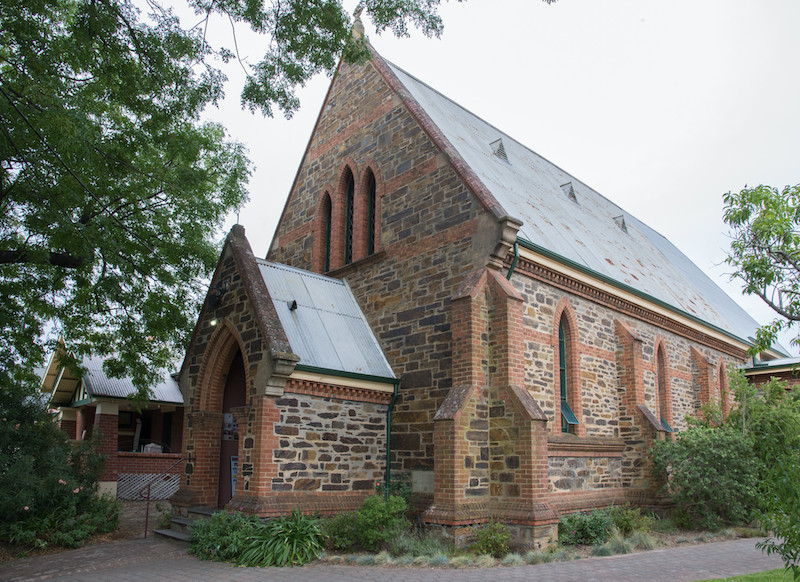 The original St David’s church is now used as our hall.
The original St David’s church is now used as our hall.
St David’s proved to be a lively parish according to Rev. Dodd’s metiсulous notes, with regular Harvest Festivals, a Mothers’ Union service, a Flower Service, a Cake and Produce Fair which in 1891 made £55.8s. Visiting notables preached, there was a Thanksgiving service in 1887 for Queen Victoria’s Jubilee and a Prince Albert Memorial Service in 1892. There was the occasional hitch also, as when on July 3rd 1887 lay reader Mr Warburton had to officiate when “Rev. B.C. Stephenson expected but failed to arrive”. The weather on Sundays was frequently noted – “Weather hot. Women fainted”. “No sermon. Very hot”. “Dust storm”. On one Sunday in 1887 Mr Dodd noted “congregation good, offertory small” at Matins while at evensong “congregation bad, offertory good”.
St David’s was growing steadily as parishioners rode, drove or walked Sunday by Sunday from scattered farms and cottages or from their village homes to worship together. From 1887 marriages were held in the new church, including – with great rejoicing — that of Canon Pymar Dodd himself in 1894. Confirmations also took place at intervals.
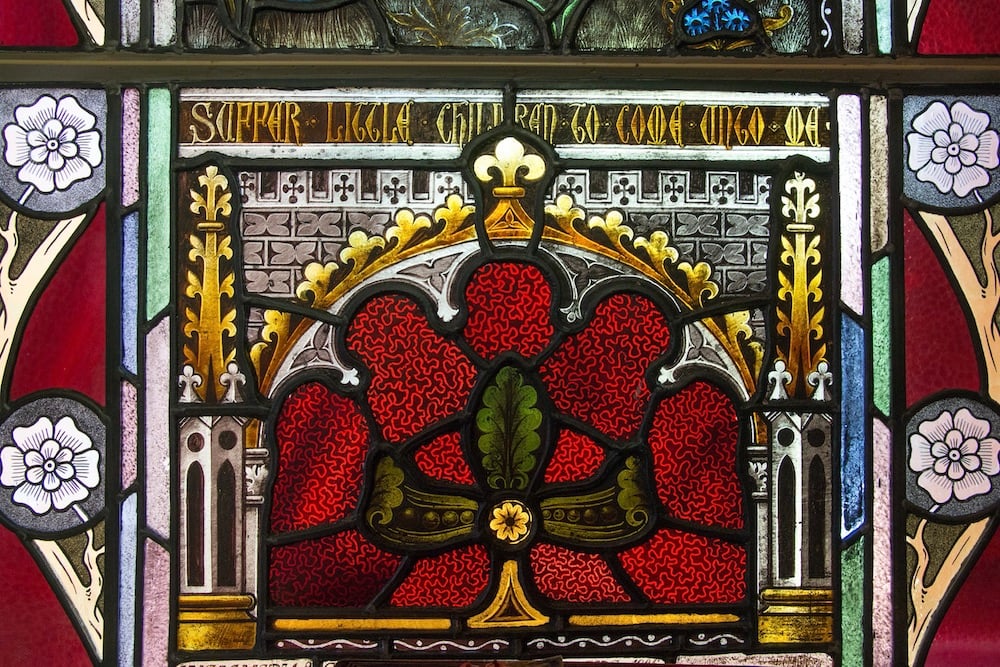 A section of the original stained glass window, now in the Lady Chapel.
A section of the original stained glass window, now in the Lady Chapel.
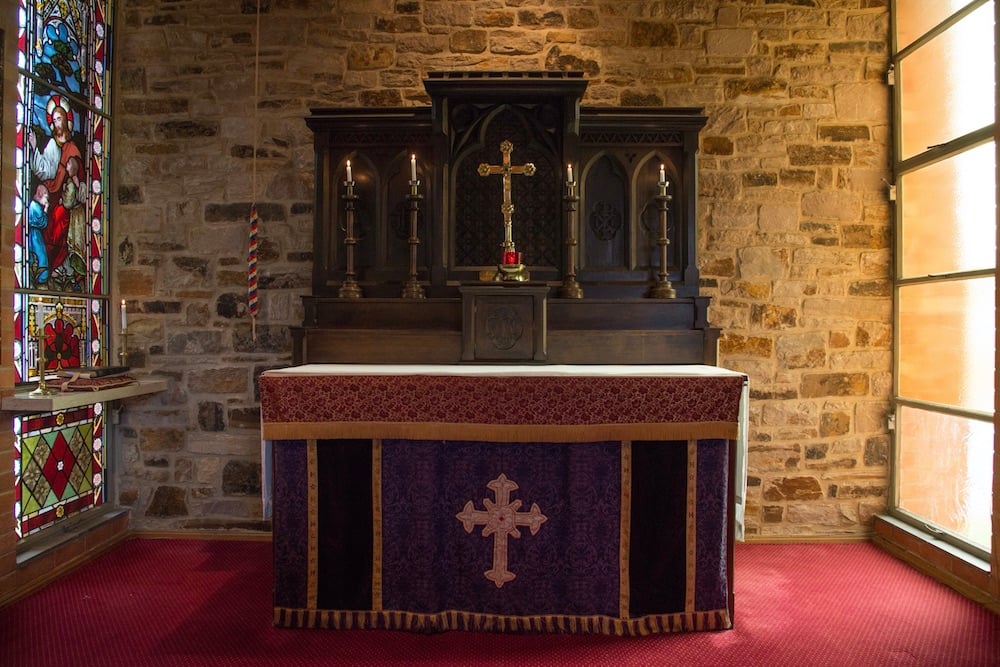 Altar from the original church, now in the Lady Chapel.
Altar from the original church, now in the Lady Chapel.
While St David’s did not have a hall or any other building in which to hold social events, a need for such was felt in order to accommodate the busy life of the Parish and in 1894, after several years of fund-raising, a hall was built on the corner of Knightsbridge Road, close to the 1883 Knightsbridge Baptist Church. Designed by architect A Barham Black, the hall was intended for dancing, theatrical performances and lectures and included a small library and reading room, a stage, underground rooms and a good floor.
Like the Baptist Church, St David’s Hall was imposing, built of local stone from the Stonyfell Quarry and standing taller than the surrounding houses and shops.
However, although the St David’s Hall enjoyed a constant and busy life central to the Parish and the local community, it lasted only the biblical three-score-and-ten years and was finally lost to the parish for want of funds and demolished in 1964.
When Canon Dodd died on February 23rd 1906 it was the end of an era of optimism in which a new church was founded and became established, overcoming various challenges to take its place as a stalwart member of the Church of England in South Australia with a vibrant and rich parish life.
The rectors who followed Canon Dodd were equally long serving, with only three incumbents over the first 70 years of St David’s.
Following on from Canon Dodd the tenure of Rev. John Warren, “a gentle and much-loved priest” stretched from 1906 to 1936, covering the years of World War I and the inter-war years and the Depression. This era saw the building of the first rectory actually owned by the parish and erected next to the church which in 1928, was still surrounded by a post and rail fence. The land for the rectory was given by Mr Wade and the foundation stone was laid by Mrs Frank Rymill, both members of the parish.
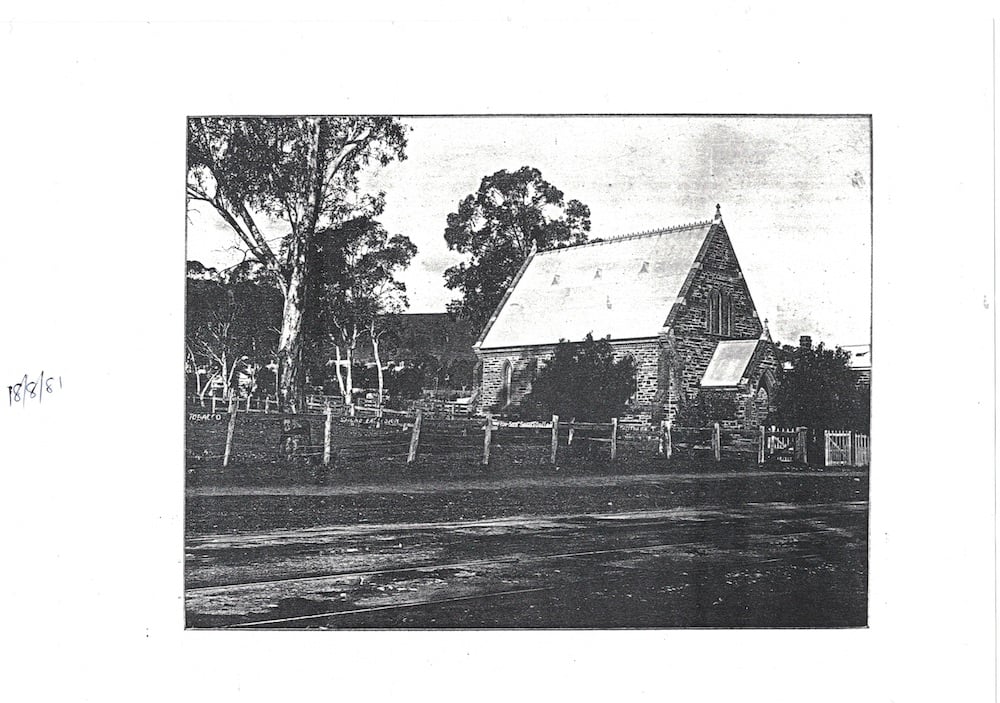 St David’s as it was in 1881
St David’s as it was in 1881
While records show 51 communicants at two services on Christmas Day 1918, by Christmas Day 1931 the number of communicants at the two services had doubled, reaching 100 for the first time.
The next rector, Rev. Leslie D.B. Riley served 20 years from 1937 to 1957, thus including the years of the Second World War. Amongst the many activities of parish life, one of his sad but regular tasks in those years was to take Memorial Services for those who lost their lives in action, including his own two sons. Michael Nugent Riley was killed at Alamein in 1942 while his brother Charles Guy Riley died also in 1942 in a flying accident over Scotland.
It was in the post-war era that the Burnside area began to be engulfed by suburban sprawl as paddocks gave way to housing and the resulting growth in parishioner numbers gave rise to plans to extend the church.
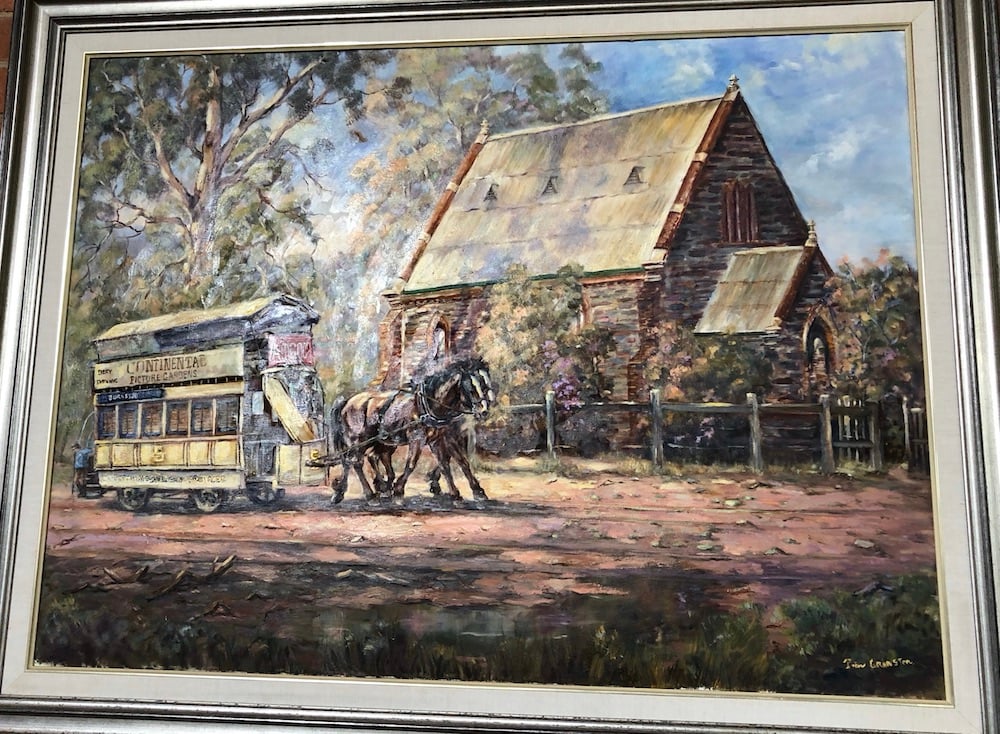 The Last Horse-drawn Tram to Burnside 1929. Painted by parishioner, Prim Cranston, the picture shows a typical horse-drawn tram of the 1920’s which travelled from the city to Waterfall Terrace. The old church featured here now serves as the Parish Hall.
The Last Horse-drawn Tram to Burnside 1929. Painted by parishioner, Prim Cranston, the picture shows a typical horse-drawn tram of the 1920’s which travelled from the city to Waterfall Terrace. The old church featured here now serves as the Parish Hall.
In 1891 the population of Burnside was recorded as 6,185. In 1901 it was 7,773, of whom 33.4% identified as Church of England, and by 1947 there were 27,942 residents of Burnside with 35.5% Church of England. The march of suburbia was truly under way but the percentage of those who were affiliated with the Church of England, or indeed any other denomination, was decreasing steadily.
It fell to the Ven. Archdeacon John Bleby, the fourth Rector, to direct his energy and vision to the building up of what was now a suburban parish. When Archdeacon Bleby came to St David’s in 1957 there were regularly over 100 communicants each Sunday and on Good Friday 1958 more than 200 worshippers crowded into the church. Clearly major work was necessary and an extension to the church (first considered in 1951) of a new sanctuary and vestry was dedicated in March 1959. However, it was accepted that this was an interim measure until the parish was in a position to plan and build a completely new church.
The Rector recorded that “the additions have been planned for use as the stage and wings of the parish hall when the new church is built and the present church becomes the Parish Hall”.
St David’s was always an integral part of the local community and in 1962 a three-way exchange of land between the church, the Burnside Council and Burnside School made available what was previously the Council’s pound yard as a site for the building of a new church. The foundation stone of the new church was laid on September 9th 1962 and blessed by the Archbishop of Adelaide Rt. Rev. T.T. Reed.
Meanwhile parish life was flourishing, experiencing an exciting period of growth and a number of new initiatives were launched during these years:
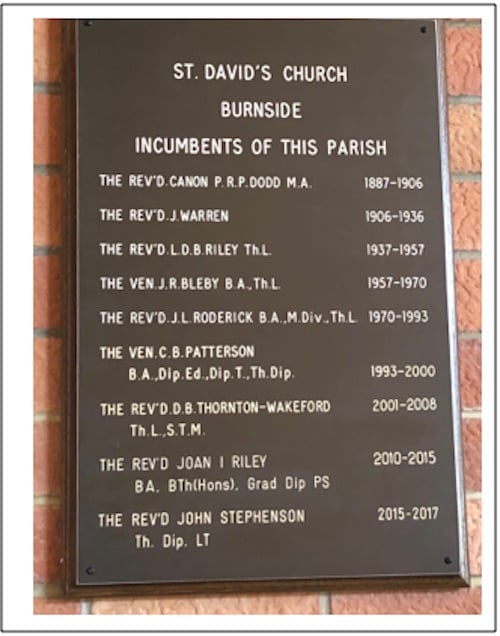
- The first planned giving campaign was conducted in November 1958 to ensure a steady income stream over the next 3 years, and indeed ongoing, and in fact the initial pledged figure of £40,805 was exceeded.
- In December 1959 a choir of 30 voices was formed, with robes made by parishioners.
- February 1960 saw the appointment of the first assistant curate, Rev. Bill Goodes, establishing St David’s as a teaching parish.
- In August 1960 a pipe organ was purchased from the Church of the Epiphany, Crafers for £1250 and installed in St David’s, launching the tradition of fine music, both within worship and in a wider setting for the community.
- In October 1960 a parish picnic was held at Long Gully with both sung Eucharist and early Evensong conducted in the open air, the first of many Parish Picnics over the ensuing years.
- The completed new church of St David was dedicated on November 9th 1963 in memory of those from the parish who had died in the two World Wars, opening the way for the next phase for St David’s Burnside.
And so begins the next stage of life of St David’s Burnside.